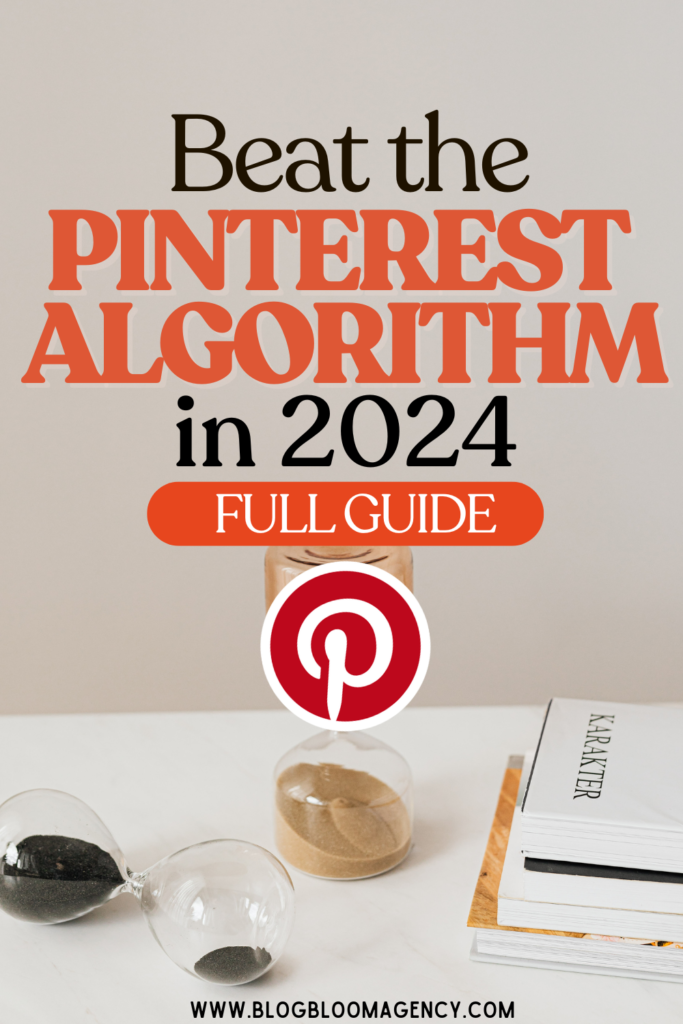Beat the Pinterest Algorithm in 2024 {Full Guide}
Master the Pinterest algorithm in 2024 with this full guide! Learn proven strategies to boost your blog’s traffic and grow your presence on Pinterest.

I am shocked & stunned on the daily, by how many bloggers out there do not understand the importance & potential of a solid Pinterest strategy for the growth of their blog. What’s more, the ones that do know they should be active on Pinterest, have very little knowledge of the Pinterest algorithm & how it works, so their efforts so often fall flat. In today’s post, I want to demystify the BIG SCARY ALGORITHM 👹 and turn it instead into a friendly furry pet, that’s happily purring on your knee. 🐹
1. Introduction to Pinterest: A Visual Discovery Engine
Pinterest stands out in the crowded landscape of social media as a platform uniquely dedicated to visual discovery and inspiration. Launched in March 2010 by Ben Silbermann, Paul Sciarra, and Evan Sharp, Pinterest has evolved from a simple idea of digital scrapbooking into a global powerhouse where over 522 million users (as of 2024) come to discover, save, and share visual content. Unlike traditional social networks that focus on real-time updates and social interactions, Pinterest serves as a visual search engine where users, or “Pinners,” can explore, curate, and plan through “pins”—images or videos linked to external content.
Pinterest’s Unique Appeal:
- Visual Discovery: At its core, Pinterest is about discovery. Users pin images or videos to themed boards, creating a personalized catalog of interests ranging from home decor, fashion, recipes, to DIY projects. This visual bookmarking tool allows users to not only collect ideas but also to plan future projects or purchases, making it a forward-looking platform.
- User Demographics and Behavior: The platform attracts a diverse user base, but it particularly resonates with individuals aged 25-34, who make up a significant portion of its audience. Users come to Pinterest not just to socialize but to find inspiration, which differentiates their behavior from other platforms. Here, the focus is on personal projects, lifestyle planning, and product discovery.

The Importance of Understanding the Pinterest Algorithm:
For content creators and marketers, Pinterest is more than just another social media platform; it’s a marketplace of ideas and products where visibility can directly translate into traffic and sales. Understanding Pinterest’s algorithm is crucial for several reasons:
- Increased Visibility: Pinterest’s algorithm determines which pins appear in users’ home feeds, search results, and related pins sections. A deep understanding of how this algorithm works can lead to higher visibility for pins, which is essential for reaching potential customers or followers.
- Engagement Optimization: The algorithm favors content that engages users, such as high-quality images, detailed descriptions, and relevant keywords. Creators who master these elements can enhance user interaction, leading to better pin performance.
- Targeted Marketing: For marketers, Pinterest acts as a bridge between discovery and purchase. By understanding user intent signals that the algorithm uses (like searches and saves), marketers can tailor content that leads users towards making a purchase or engaging more deeply with a brand.
- Strategic Content Creation: Knowing what the algorithm prioritizes (like fresh content, relevance to search queries, and user engagement metrics) helps in crafting content strategies that align with user interests and algorithmic preferences, thereby maximizing the reach and impact of the content.
2. What is the Pinterest Algorithm?
Pinterest algorithm, often referred to as a “smart feed,” is the backbone of how content is discovered and displayed on the platform. Unlike traditional chronological feeds, Pinterest uses a sophisticated system to curate a personalized experience for each user. Here’s a deeper look into what makes this algorithm tick:

The Essence of the Pinterest Algorithm:
Pinterest operates primarily as a visual search engine rather than a conventional social network. This means its primary function is to help users find what they’re looking for through visual cues and related metadata, not just by who they follow or their social interactions.
Key Components of the Pinterest Algorithm:
1. User Engagement:
Engagement Metrics such as saves, clicks, comments, and close-ups play a significant role. Pins that generate more engagement are deemed more relevant and are thus pushed higher in search results and user feeds.
2. Pin Quality:
Pin Quality refers not just to the visual appeal but also to the relevance and usefulness of the pin’s content. High-quality images, clear text overlays, and compelling pin descriptions contribute to a pin’s quality score.
3. Domain Quality:
Pinterest assesses the Domain Quality where the pin leads to. Websites that are deemed trustworthy, with high-quality content that engages Pinterest users, will see their pins receive better algorithmic treatment.
4. Pinner Quality:
The Pinner Quality reflects the credibility and activity level of the person or entity pinning the content. Consistent pinners who engage well with the community often have their pins favored by the algorithm.
5. Topic Relevance:
Topic Relevance involves matching pins to user searches and interests. The algorithm analyzes the pin’s content, including titles, descriptions, and even the visual elements to ensure it matches with what users are looking for or might be interested in.
How Pinterest Algorithm Differs from Other Algorithms:
- Focus on Discovery: While platforms like Instagram or X focus heavily on real-time content from your network, Pinterest aims to help users discover new content outside their immediate circle, based on their interests.
- Longevity of Content: Content on Pinterest has a much longer shelf life. A pin can resurface months or even years after being first posted if it remains relevant, unlike the fleeting nature of posts on other platforms.
- Search Optimization: Pinterest’s algorithm heavily incorporates SEO principles. Pinterest SEO involves optimizing pins and boards with relevant keywords in titles, descriptions, and hashtags to improve visibility in search results.
- Content Freshness: Unlike some algorithms that might prioritize newer content indiscriminately, Pinterest values Fresh Content that’s not only new but also unique and adds value to the platform, encouraging creators to regularly update their offerings with new pins.
For anyone looking to leverage Pinterest for personal projects, business growth, or brand visibility, understanding these algorithmic nuances is not just beneficial; it’s essential. By aligning content strategies with how Pinterest’s algorithm works, creators can significantly enhance their content’s reach, tailor their material to fit user expectations, and ultimately achieve better engagement and conversion rates. This makes Pinterest not just a place for inspiration but a strategic tool for digital marketing and content discovery.
3. Core Components of the Pinterest Algorithm
Understanding the mechanics of Pinterest’s algorithm requires a closer look at its core components, each playing a pivotal role in how content is ranked and displayed. Here’s an in-depth exploration of these elements:

Domain Quality
- Definition: Domain Quality reflects the trustworthiness and relevance of the website from which a pin originates. Pinterest evaluates domains to ensure that users are directed to safe, useful, and engaging content.
- Impact on Pins:
- High-Quality Domains: Pins from domains recognized for their high-quality content, user experience, and credibility are more likely to be favored by the algorithm. This includes sites with good load times, mobile optimization, and positive user feedback.
- Low-Quality Domains: Conversely, domains with poor user experience, misleading content, or those marked for spam might see their pins demoted or less visible.
- How to Improve Domain Quality:
- Ensure your website is mobile-friendly, fast-loading, and provides valuable content.
- Regularly update your site with fresh, relevant content to keep Pinterest users engaged after they click through.
Pin Quality
- Definition: Pin Quality encompasses the visual appeal, clarity, and utility of the pin itself. It’s not just about aesthetics but how well the pin delivers on its promise.
- Factors Influencing Pin Quality:
- High-Quality Images: Clear, high-resolution images that are visually appealing.
- Engagement: Pins that receive more saves, clicks, and comments are considered high quality.
- Relevance: How well the pin matches with the user’s search or interest, including the accuracy of the pin’s title, description, and the linked content.
Want to know how to best optimize your pins? Grab our FREE PIN OPTIMIZATION PRINTABLE!
Pinterest Pin Optimization Checklist
Grab my free Pinterest Pin Optimization Checklist and learn how to create eye-catching, traffic-boosting pins that get noticed!
Pinner Quality
- Pinner Quality assesses the credibility and the engagement level of the person or brand creating the pins. It’s about how much Pinterest trusts the pinner to provide valuable content.
- Elements of Pinner Quality:
- Activity Level: Regular pinning and interaction with other users.
- Engagement with Followers: How well the pinner engages with comments, re-pins, etc.
- Consistency: A track record of posting high-quality, relevant content over time.
- Strategies to Enhance Pinner Quality:
- Engage actively with your audience through comments and by re-pinning relevant content.
- Maintain a consistent pinning schedule with fresh, original content.
Topic Relevance
- Topic Relevance ensures that the content of the pin matches the interests of the user or their search query. This is where LSI (Latent Semantic Indexing) keywords come into play, helping Pinterest understand content context beyond simple keywords.
- Role in the Algorithm:
- Keyword Integration: Using relevant keywords in pin titles, descriptions, and board names to align with what users are searching for.
- Content Context: The pin should match the broader context of the user’s interests or the theme of the board it’s pinned to.
- Improving Topic Relevance:
- Conduct keyword research to find what your target audience is searching for on Pinterest.
- Use relevant boards to categorize pins, making it easier for Pinterest to understand and display your content in the right context.
4. The Role of Fresh Content
In the ecosystem of Pinterest, where discovery and inspiration reign supreme, the algorithm places significant emphasis on fresh pins. Understanding and leveraging this aspect can dramatically enhance visibility and engagement on the platform. Here’s a detailed look at why fresh content matters and how to effectively incorporate it into your Pinterest strategy:

Why Fresh Content Matters:
- Algorithmic Preference:
- Pinterest’s algorithm favors new pins because they encourage user engagement and return visits. Fresh content indicates to Pinterest that your page is active and providing current, valuable information or inspiration, which can lead to higher rankings in search and home feeds.
- User Experience:
- Users come to Pinterest to discover new ideas, trends, and products. Fresh content meets this need by offering the latest in fashion, technology, DIY projects, recipes, or any other interest area, keeping the user experience dynamic and engaging.
- Increased Visibility:
- New Pins can appear in the “Following” tab, “Today” tab, and as “Picked for You” pins, which are prime real estates for exposure on Pinterest. This visibility can lead to a higher initial engagement rate, which in turn signals to the algorithm that the content is worth promoting further.
Strategies for Creating Fresh Content:
- Regularly Update Your Boards:
- Consistently add new pins to your boards. This doesn’t always mean creating entirely new content; it can also involve pinning new finds from other creators or repining older content in a new context.
- Create Seasonal or Trend-Relevant Content:
- Align your content with current trends, seasons, or events. This not only provides fresh content but also taps into what users are actively searching for or interested in at that moment.
- Repurpose and Refresh Old Content:
- Update older pins with new images or slightly modified descriptions. This can breathe new life into content that has performed well in the past.
- Use Different Formats:
- Experiment with video pins, idea pins, or rich pins to add variety to your content. Each format can attract different segments of your audience or engage users in unique ways.
- Engage with New Trends Quickly:
- Stay on top of emerging trends or news within your niche. Being one of the first to pin content related to a new trend can significantly boost your pin’s visibility and engagement.
Best Practices for Fresh Content:
- Consistency Over Quantity:
- It’s better to pin regularly (even if it’s fewer pins) than to pin a large number at once sporadically. Consistency helps keep your followers engaged and signals to Pinterest that your account is active.
- Quality Over Quantity:
- While freshness is key, never sacrifice the quality of your content. High-quality, visually appealing pins will always outperform lower quality images or irrelevant content, no matter how new they are.
- Monitor Performance:
- Use Pinterest Analytics to see which types of fresh content perform best. Adjust your strategy based on what works, focusing on themes or formats that resonate with your audience.
- Diversify Content Sources:
- Don’t rely solely on your original content. Curate and share content from other creators that aligns with your brand or theme. This not only adds freshness but also builds community.
Need help with regular fresh content creation? We got you!
5. Search Optimization on Pinterest
Search optimization on Pinterest, or Pinterest SEO, is crucial for ensuring that your pins are discoverable by users actively seeking inspiration or information. Unlike traditional SEO, Pinterest SEO focuses on how users search visually and textually within the platform. Here’s how to optimize for Pinterest search:

Understanding Pinterest SEO Basics:
- Keywords are Key:
- Keyword Research: Just like with web SEO, understanding what terms your target audience uses is fundamental. Use Pinterest’s own search bar, Pinterest Trends, or external tools to find relevant keywords that are popular within your niche.
- Pin Titles and Descriptions:
- Pin Title: Your pin’s title should be clear, descriptive, and include primary keywords. A well-crafted title not only attracts clicks but also helps Pinterest understand what your pin is about.
- Pin Descriptions: Incorporate secondary keywords here. Descriptions provide an opportunity to expand on the pin’s content, include calls to action, and tell Pinterest more about the context of your pin.
Optimizing Your Profile for SEO:
- Profile Name and Bio:
- Use keywords in your profile name and bio. If you’re a business, include what you do or sell. For personal accounts, describe your interests or expertise.
- Board Titles and Descriptions:
- Each board should have a relevant board name that includes keywords related to the board’s theme. The board descriptions should also contain keywords to enhance visibility in search results.
Enhancing Visibility with Content:
- High-Quality Images:
- Pinterest is a visual platform, so high-quality images are non-negotiable. They should be clear, well-lit, and aesthetically pleasing. Vertical images typically perform better.
- Text Overlay:
- Adding text overlay to images can make your pins stand out in search results. It succinctly tells viewers what the pin is about before they even click through.
- Rich Pins:
- Utilize rich pins (product, recipe, article, app) that provide more context by including extra information directly on the pin itself. Rich pins are updated dynamically if the source information changes.
Leveraging Hashtags and Keywords:
- Hashtags:
- While Pinterest has shifted focus from hashtags to keywords, using a few relevant hashtags can still help with discoverability, especially for trending topics or events. Place them at the end of your pin description.
- Keyword Placement:
- Place keywords naturally within the first few words of your pin description for maximum impact. Remember, Pinterest’s algorithm and users both appreciate clarity and relevance.
Engagement and Analytics:
- Encourage Engagement:
- Pins that get more engagement (likes, saves, comments) signal to Pinterest that the content is valuable, which can improve its ranking. Crafting content that invites interaction can boost your SEO indirectly.
- Using Pinterest Analytics:
- Regularly check Pinterest Analytics to see which pins are performing well. Analyze metrics like impressions, saves, and click-through rates to refine your keyword strategy and content focus.
Keeping Content Evergreen:
- Timeless Content:
- While staying current with trends is beneficial, creating evergreen content ensures your pins remain relevant over time, continually attracting new pinners.
SEO Best Practices
- Mobile Optimization:
- Since a significant portion of Pinterest users access the platform via mobile devices, ensure your website and images are optimized for mobile viewing to improve user experience.
- Follow Pinterest’s Guidelines:
- Stay updated with Pinterest’s best practices for content creators. Adhering to these guidelines not only avoids penalties but can also enhance your content’s performance in search.
6. Engagement and User Experience
The Importance of Engagement:
Engagement on Pinterest isn’t just about getting likes or repins; it’s a critical component that influences how the algorithm prioritizes content. Here’s why engagement matters:
- Algorithmic Boost: Pins with higher engagement rates (saves, comments, close-ups, and click-throughs) are often deemed by Pinterest’s algorithm as high-quality content, thereby increasing their visibility in home feeds and search results.
- Creating Engaging Content:
- Interactive Elements: Encourage users to engage by asking questions in your pin descriptions or creating pins that solve a problem or teach something, inviting users to save for later or try themselves.
- Visual Appeal: Use high-quality, striking images or infographics that stand out in the feed, compelling users to engage.
Enhancing User Experience:
The user experience on Pinterest can make or break the engagement with your pins:
- Pin Design:
- Clarity: Ensure your pins are clear, with text overlays that are readable on small screens. The design should convey the pin’s purpose at a glance.
- Aesthetics: A visually pleasing design not only attracts attention but also encourages shares and saves, as users associate aesthetic content with value.
- User Feedback:
- Incorporate Feedback: Use comments and saves as feedback to tweak your content strategy. What are users saving the most? Which pins get the most comments? This data helps refine content to match user interests.
- Consistency:
- Regular Interaction: Regularly updating your boards and interacting with followers through comments can foster a community feeling, encouraging more engagement. Consistency in quality and theme helps in setting expectations, which can lead to higher user retention.

Mastering Pinterest involves a blend of creative content creation, strategic use of SEO, understanding and leveraging engagement, and adapting to the platform’s evolving features. By focusing on these areas, content creators and marketers can significantly enhance their presence on Pinterest, leading to better engagement, increased visibility, and ultimately, greater success on the platform.
Need help with your Pinterest Journey?
We help creators just like you achieve their blogging & business dreams by leveraging the power of Pinterest, all day every day! Check out our services and let’s get to work!







